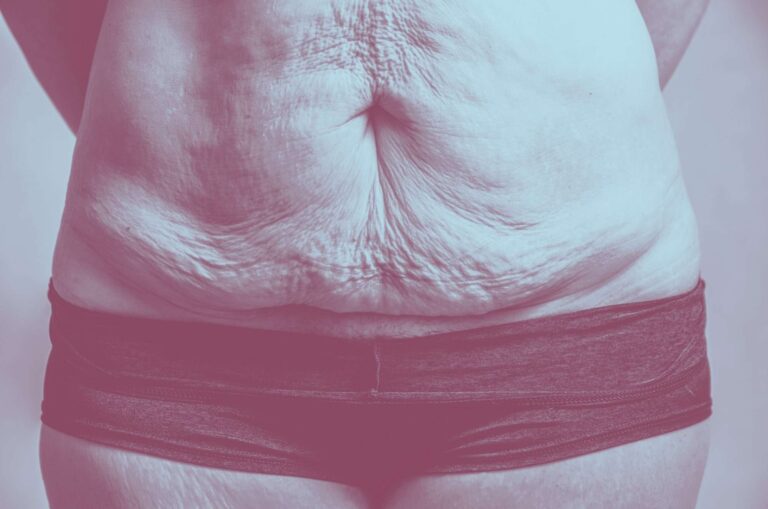Losing weight and keeping it off can be difficult. Some people may then experience another factor: excess skin after weight loss.
Many people who have lost weight accept and love their skin and stretch marks. However, for others, loose skin – often around the arms, legs, neck and waist – can be uncomfortable or even painful.
See what works, what doesn’t, and what people should know before considering surgery.
In general, the skin has some degree of elasticity, known as skin turgor. This degree of elasticity is different for everyone and depends in part on their overall health and the health of their skin.
The appearance of excess skin also depends on how much weight a person loses and how quickly they lose it. Losing a lot of pounds at once or in general, say at least 100 pounds, can lead to loose skin.
Excess skin can occur in people who lose a lot of weight through diet and exercise changes. Also, people who have bariatric surgery and lose a large amount of weight at the same time will likely have some excess skin afterward.
One study said that people who undergo bariatric surgery – up to 90% – have excess skin after the procedure. Excess skin around the stomach can appear after losing weight after pregnancy—especially if one has given birth to multiples.
Physical and psychosocial problems can occur if you have excess skin. They include:
- Dermatitis or eczema
- Difficulty finding clothes that fit
- Issues with sex or intimacy
- Restrictions on dressing or being active
- Problems with hygiene
- Rashes or sores on extra or hanging skin
- Risk of skin infections and irritations
- Skin odor, heaviness and pain
There are non-surgical treatments available to keep your skin as healthy as possible, including:
- Drinking lots of water and staying hydrated
- Keeping the skin protected from the sun
- No smoking
- Using moisturizer
However, none of these techniques will get rid of the extra folds of skin due to weight loss. Creams, supplements or exercises that specifically target certain parts of the body are also ineffective.
Surgery to remove excess skin, also called skin excision, or body contouring must be performed by a board-certified plastic surgeon. These procedures involve large incisions, so patients are generally put to sleep using general anesthesia.
The extent of the procedure and the recovery time required depends on the body parts involved. Common skin excision surgeries focus on:
- Abdominal area – abdominoplasty, also called abdominoplasty
- The upper arms — brachioplasty or arm lift
- Thighs
- Chest or breasts—for all sexes
- Face
- Neck
Some patients opt for a full lower body lift. It is a procedure that tightens the skin around the thighs and buttocks with an incision that runs around the waist.
Some people, in addition to excess skin, also have extra pockets of fat that won’t budge no matter how much they diet or exercise. Liposuction—a procedure that removes fatty tissue—could also be performed along with skin excision procedures.
These procedures can be expensive and are often not covered by insurance. However, agencies may approve certain procedures if health care providers and patients can argue that the excessive skin folds caused pain or infections.
Skin excisions involving larger incisions, especially those around the waist, may require several days in the hospital. On the other hand, a patient undergoing an arm lift could be sent home the same day. Body contouring procedures could also fall under any circumstance.
Some skin incisions may take at least six weeks to heal. Healthcare providers and patients should monitor each other closely during this time.
Ultimately, it can take up to two years to see results after surgery to remove excess skin.
There are a few other things to consider if you want to have surgery for excess skin, such as eligibility and risks.
Not everyone will be eligible for the surgery
It’s not a good idea to have surgery for excess skin if you’re still losing weight—or if there’s a good chance you’ll gain it right away. The ideal time is if you have reached your ideal weight and have maintained it for at least six months.
Sometimes, a plastic surgeon may refer you to a nutritionist or personal trainer to help you with weight loss before tackling procedures for excess skin. Healthcare providers will also consider a patient’s overall health when determining whether they are a good candidate for surgery.
You should choose surgeons and facilities carefully
Body contouring procedures can be performed in either hospitals or ambulatory surgery centers. However, you should make sure to consult with a board-certified surgeon who works in an accredited facility. Surgeons should also be able to discuss their goals for the surgery with you.
There are risks associated with surgery
As with any type of surgery, there should also be some risks discussed with a health care provider before you decide to proceed. For example, body contouring surgery can lead to complications such as blood clots, infection, or heavy bleeding. In addition, skin excision surgery may cause swelling and pain or discomfort.
It is common for weight loss to cause excess skin, which can be uncomfortable or painful. Recovery depends on how much skin you want to remove, so it can be a quick process or involve multiple surgeries over time. If you want to get rid of excess skin after losing weight, consult a health care provider for surgical treatment options.


